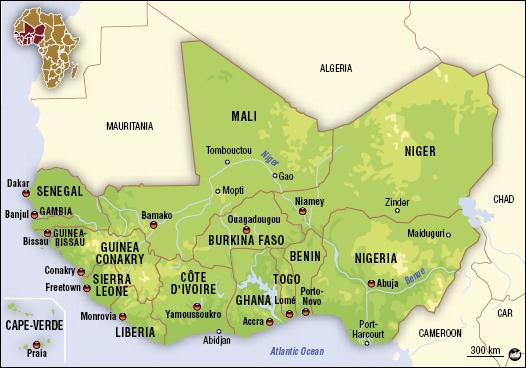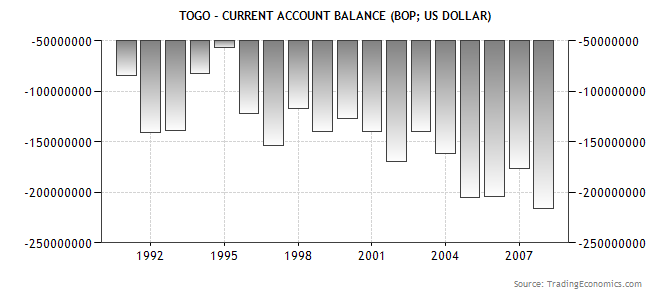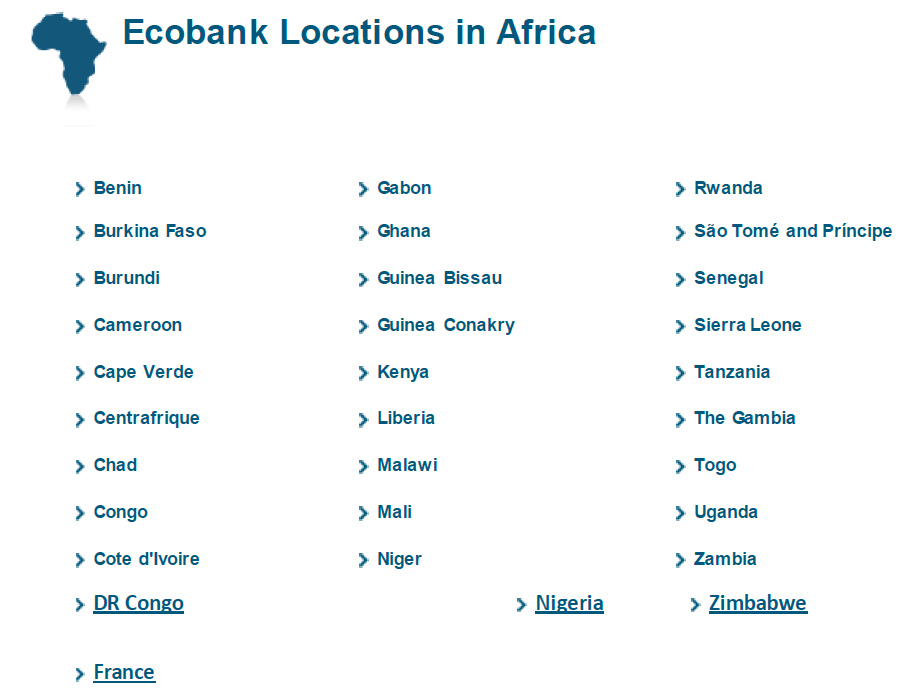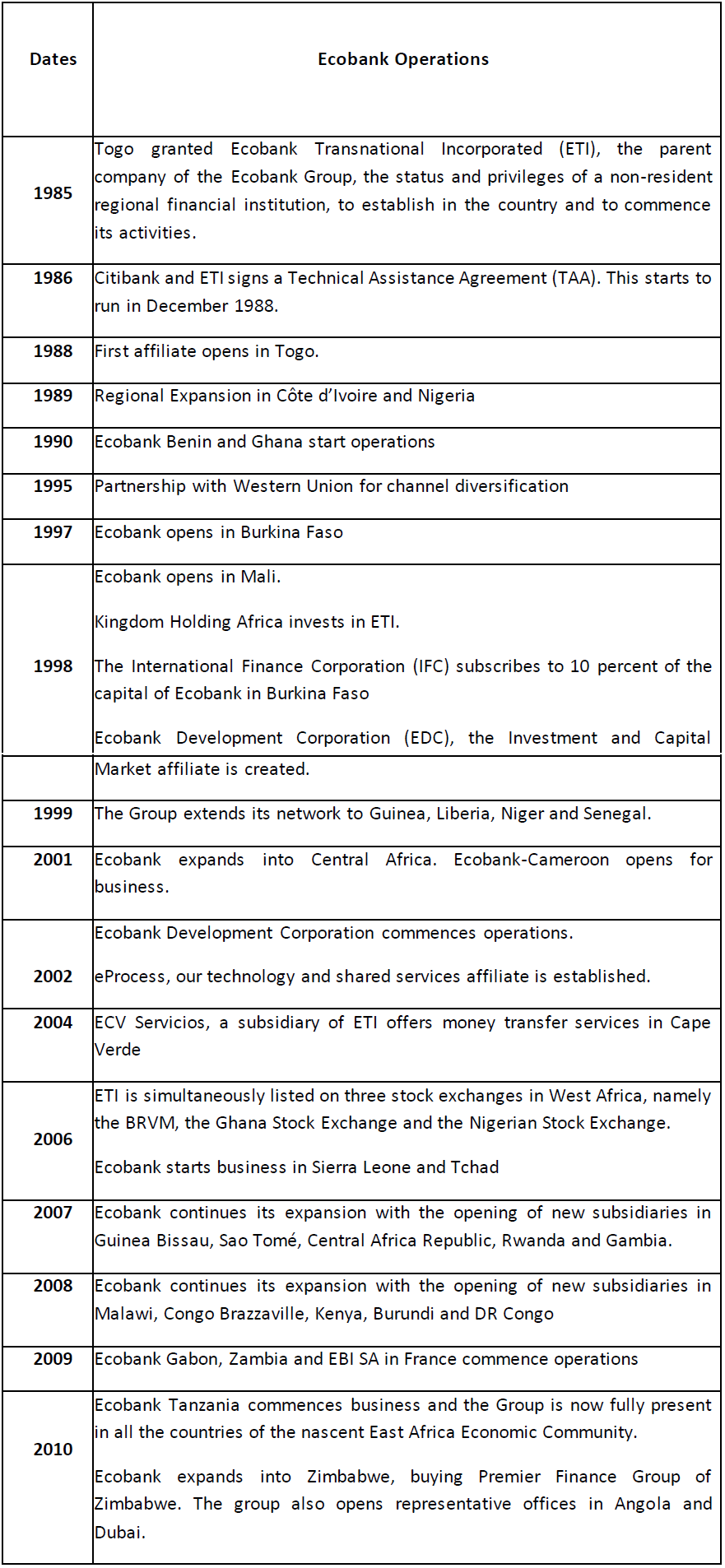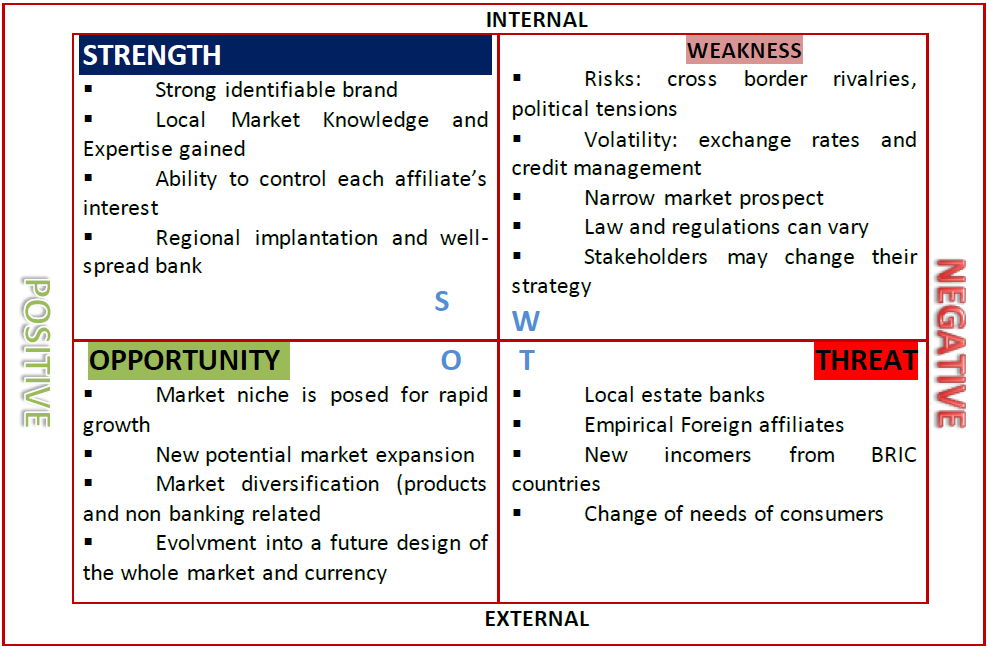Serving as a regional commercial and trade centre, encouraged by the IMF and World Bank, to boost economic situation of the country, Togo launched new measures and reforms to attract FDI, in the nineties. These perhaps pushed the transformation of Togo to innovate and develop an unusual business model for the continent for better success, which has maybe brought to light Ecobank, as one the West African major success stories .
Figure 16. West African map
Source : http://www.the a fri ca re port.com/201011113278635/we s t-a fri ca /country-profi l e -togo.html #country
4.1. FINANCIAL INDUSTRY IN TOGO – OVERVIEW
4.1.1. Country performance overview
Togo is a small country, with a population of around 6.8 million; situated in West Africa. It is a member of a trade bloc the West-African Economic and Monetary Union (WAEMU or UEMOA) and is also part of West African Franc Zone CFA (XOF). The UEMOA currency is the West African Franc CFA (XOF), linked with an agreement with the former French Franc to ensure stable convertibility. The agreement was renewed in 1994 with the reorganisation of the institution and parity with the €uro at 655.957 FCA (XOF) for 1€. Togo is in the low-income category of countries and has in average $440 GDP per capita, compared with an average $510 for its category and $1.165 for the Sub-Saharan region (UN, 2011).
Figure 17. Togolese main indexes
Source: http://www.theafricareport.com/201011113278635/west -africa/country-profile-togo.html#country
UEMOA is a sub-group of the Economic Community of West African States (ECOWAS), the regional bloc of 15 countries which aims at encouraging the social and economic growth and improvement of its members. ECOWAS members include: Benin, Burkina Faso, Cap-Verde, Cote D’Ivoire, Ghana, Guinea, Guinea Bissau, Liberia, Mali, Niger, Nigeria, Senegal, Sierra Leone, The Gambia and Togo. ECOWAS is composed of 2 sub-blocs: UEMOA and WAMZ. The region represents 25 percent of African land, 34 percent of population. 50 percent of the population live in absolute poverty and 41 percent live in urban areas. ECOWAS, is a very low income region with an average per capita income of around $400. It includes 11 less developed countries and 4 developing countries. Trade within the region represents just 10 percent of total trade while 40 percent of trade is done with the European Union (EU).
Article 55 of the ECOWAS constitution argues for the establishment of a single currency by 2020: the West African Currency. However, the financial integration of Togo within a bloc is not recent. It dated from French empire. According to Hanohan and Beck (2007), the background of many of the countries is difficult with many conflicts especially in Liberia and in Cote d’Ivoire. These have further delayed financial integration. ECoWAS’s headquarters is in Abuja in Nigeria. Also, some countries are more advanced like the UEMOA countries. The ECOWAS’s trade integration tends to follow rather than lead its financial integration. Some indices show for example that, the current account of Togo is minus 216 million US Dollar.
Figure 18. Togolese balance
The major industry in the country is the cotton industry generating about 50 percent of the 480 billion GDP. Togo had a growth rate of 3.409 percent in 2010 and a gross capital formation (the last known was) in 2005 of about 18.4 percent. The rate of urbanisation of the population is 24 percent. . Also, Togo has a life expectancy at birth of 63 years, a literacy rate of 57 percent of the population above 15 of age and a 61.7 percent poverty index, according to (World Bank, 2011). The country’s data are not readily available but depend on long time surveys, and estimation of growth done by the IMF. Nevertheless, in a country difficult to study without a deep and long analysis in place, something unusual is happening in the financial sector which is barely embryonic. Within Africa, West African banks represent 17 percent of the total and generate only 6 percent of the revenue, in the region where less than 5 percent of the population have bank accounts. The region is still under influence of the former colonial power and is tied by the agreement of parity with the major currency the XOF. Nevertheless the last 20 years has seen the emergence of regional banks with sometimes different structure and compositions. Some of them are: Bank Atlantic; Bank of Africa and Ecobank.
4.1.2. Financial sector organisation
The banking system is composed of eleven commercial banks wherein the government holds stakes in six of them. This represents about 67 percent of the total stakes circulating in the sector. These banks are very small in size which is not favourable for economies of scale therefore leaving them with inefficiencies, according to the (World Bank, 1 July 2011). It poses big challenges for them to face in the future for competitiveness seeking by privatising, but the right structure is still to be defined. Following the narrowness of the Togo financial sector cannot be analysed in the base of national advantage as suggested Porter (1990) via the national Diamond. Because of some lacks for example, factor endowments: the human and knowledge resources in term of the number of skilled people including managers and engineers are very low and its quality is beyond the understanding, but (UNDP, 2009) and (AUC, 2009) took on board that factor is the scale of the whole continent to improve the education sector. The physical resources might be abundant but not real infrastructure enabling its development, by lack of funding. The capital resources are mostly provided by the estate or international institution, and it is just into hands of few people. Togo as UEMOA member composed by Benin, Burkina Faso, Cote d’Ivoire, Guinea-Bissau, Mali, Niger, Senegal and Togo. They benefit of one single currency facilitating exchanges between nations. The bloc has one central bank BCEAO (Banque Centrale des Etats de L’Afrique de L’ouest) West African Central Bank in English and one institution of supervision and regulation called the West African Monetary Institute. UEMOA’s headquarter is in Dakar in Senegal and has adopted the OHADA (organisation for the Harmonisation of Business Law in Africa), with the IFRS norms implemented, the standardisation with the international market and comparison is enabled; and just a single stock market and regulator. At date, no restriction on capital flow in theory but the outflow required an authorisation of the Ministry of Finance.
Payments in whole Africa are still done in cash. Common tariff are in place by principle but the rate differs to one country to another leading to cross country tariffs different in the region. No real liberalisation and many formal and informal barriers and bureaucracy restricting foreign firm’s installation. The credit information is not yet available. Nonetheless, Ecobank is the region’s most successful bank in the UEMOA.
However Togo is not listed in the Global Competitiveness 2011 report. With its average GDP per capita income situated at $ 440 in 2009, put de facto the country into the stage 1 which is mainly based on the basic requirement factors driven. As the report argued, Africa has growth economically over the past decade in 2010 according to IMF, analysed a growth of 4.7 per cent and predicts for the sub-Saharan region a growth above 5 percent in the future. With a minor role of the financial system in the country but the private sector is booming about 80.6 percent in since 2009.
4.2. ECOBANK
Figure 19. Logo Ecobank
Source: www.ecobank.com
4.2.1. ECOBANK – Overview
Ecobank whose holding name is Ecobank Transnational Inc. (ETI), is a private Pan-African (34) financial institution, serving wholesale and retail customers in more African countries more than any other bank. It is the leader in West and Central Africa.
Figure 20. Ecobank presence
Source: http://www.ecobank.com/yourcountry.aspx
Ecobank operates in thirty-two countriesi almost totally based in Africa, serving wholesale and retail customers. The holding was founded in 1985 with the help of the West African Chamber of Commerce in response to the lack of private sector banks in the region. Key to Ecobank’s success has been its willingness to enter markets that have traditionally been seen to be not particularly promising or lucrative; such as Liberia and the Central African Republic (CAR), and confirmed also by this statement “[Ecobank] operates in countries such as Sierra Leone and Zimbabwe, where there is no real profit to be had” (Rugimbana & Spring, 2009: 152); suggesting that Ecobank has made a business model that exploits markets ignored by other banks.
Ecobank is fairly healthy, financially. “For the year 2008, the most recent year for which full figures have been released, the bank had revenue of $162m and total assets of more than $8bn” (Ecobank, 2010).
Table 4-1. Ecobank evolution
Source: Author, Adaptation of http://www.ecobank.com/group/ourgrowth.aspx
4.2.2. SWOT Analysis
To analyse the driving forces of Ecobank, its strategy and the reason of its success while Togo’s financial sector struggles to develop, a SWOT analysis has
been carried out.
Table 4-2. Ecobank SWOT analysis
Source: Author
Ecobank is a well-spread and well-known banking brand, which uses its local knowledge to grow and its expertise to be able to adapt into the African
environment.It has been able to develop suitable banking solutions for Africa and Africans as the foundation of its strategy and source of profits. Also, Ecobank has started to diversify its consumer niche by creating solutions suitable for businesses and corporates through two specialised affiliates such as Ecobank Development Corporation and Eprocess international. These should provide for future development of Ecobank’s activities. To deal with the competitors’ threats, Ecobank has a strong plan for its development and will continue to respond to a fast growing demand in Africa within the financial sector. It also has a better understanding of the environment in which it operates and is favoured by local regulation which is oriented and specific to domestic firms leaving an open door for a greater future for Ecobank.
Ecobank, operates in many countries in Africa which represent a political risk, but its model, diversified in term of assets coverage, is absolutely adequate and suitable for the relatively unregulated African environment andminimises the risk in a particular country. Concerning exchange rate fluctuations and volatility, Ecobank uses these as driving forces for expansion in the still unregulated African Financial sector, while foreign firms are too timid to undertake that kind of risk.
4.3. CONCLUSION
Ecobank pushes the boundaries of innovation in Africa, at the country level, no real industry structure and lack of domestic rivalry but a factors endowment as more base on the local knowledge and a willingness of a region to develop a banking structure for African in Africa. Therefore, making Ecobank more than a financial institution but a social actor developing in the community, to fulfil its needs, with the possibility to a development, at the moment which is intra-industry FDI might to lead to an interindustry FDI specialisation to respond to a fast growing demand in Africa as suggested (Busson and Villa, 1994). Also, according to Hymer (1960 and 1976) Ecobank might wellperformed than foreign firms because the countries would like to be hand off into the sector and Ecobank has a better understanding of its environment in which it operates.
The local context might be privileged via financial repressions faced by foreign firms towards an excessive governmental intervention in domestic financial sector entailed restrictions on entry and operation of foreign banks, because they are suspected to not have long term commitment and objective in developing countries, leaving the door totally open for African firms, (Caprio et al., 2001: 4). This enables Ecobank to develop a competitive advantage. Finally, in the world scene Ecobank started to demonstrate and use its expertise for greater partnerships.
3 Pan-Africanism: movement that tries to unify African people (living in and aboard of Africa) and those so called having an African heritage in different level social racial, politic unity or economic. (Howe, 1999)
4 Stephen Howe, Afrocentrism: mythical pasts and imagined homes, 1999: “Since it is often difficult, if not impossible, especially in the United States, to identify Afro-American cultural traits as deriving from particular African peoples, it has become important for some intellectuals to emphasize that distinctions between those people were essentially insignificant, so that descent from a generalized ‘Africa’ bec omes more meaningful.”(p. 103)
Page suivante : Chapter 5 : CASE STUDY FINDINGS: Description, Analysis and Discussion

